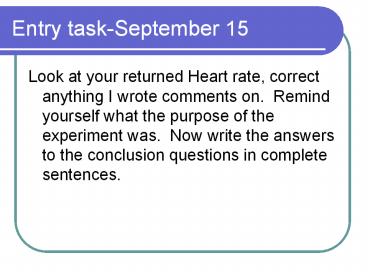Entry task-September 15 - PowerPoint PPT Presentation
1 / 13
Title:
Entry task-September 15
Description:
Entry task-September 15 Look at your returned Heart rate, correct anything I wrote comments on. Remind yourself what the purpose of the experiment was. – PowerPoint PPT presentation
Number of Views:79
Avg rating:3.0/5.0
Title: Entry task-September 15
1
Entry task-September 15
- Look at your returned Heart rate, correct
anything I wrote comments on. Remind yourself
what the purpose of the experiment was. Now
write the answers to the conclusion questions in
complete sentences.
2
How to write a Conclusion
- You asked a question, you did an experiment, and
you did the experiment a second time. You
recorded your results. Now it is time to write
your conclusion. The conclusion, plain and
simple, is the answer to your question. It should
be clear, concise and stick to the point. Resist
the temptation to jump to conclusions. - If you were to do your experiment again, would
you get the same results? - Can there be differences? Why?
- Ask yourself what happened when you tested your
hypothesis. - What have you learned from this experiment? What
does this experiment tell us - Now for homework-- using the answers to the
questions on the heart rate lab, write a final
report summarizing your question, research
methods and conclusion. Must be printed neatly
or typed (5 points extra credit)
3
Agenda
- Entry task
- Conclusion writing and homework instructions
- Daphnia Lab Instructions
- Daphnia Lab
- Homework Conclusion for heart rate lab on
separate sheet of paper in paragraph style
4
Learning targets
- I can write a scientifically based conclusion
- I can perform an experiment on a living organism
to test the effects of different chemicals.
5
Review of Microscope
- Use your assigned microscope and return it to its
proper place as instructed - Always start on low power
- Make sure your lenses are clean
- We will be using depression lenses, make sure
your Daphnia is in the well and do not overflow.
6
Bioassays
- Dose/Response Bioassays are used to
- Estimate toxicity to humans.
- Estimate maximum concentrations of specific
chemicals allowed to discharge into bodies of
water. - Investigate hazardous waste sites.
7
Bioassay Species
- 3 organisms are often used
- Daphnia
- Duckweed
- Lettuce Seeds
- Expose organisms to chemicals and measure how
they respond.
7
8
Remember you are working with a living creature
- http//www.microscopyu.com/moviegallery/pondscum/d
aphnia/ - At the end of each experiment return your daphnia
to the Rehabilitation and Recovery area on the
demonstration desk. Use a new daphnia for each
chemical
9
Daphnia
10
Part 1
- Take a look at your daphnia on low power-use the
sketch I put on the overhead to help sketch and
label your daphnia - Look at your daphnia on medium power and sketch
and label what you see - Do not use high power with daphia or well plates
11
Part 2
- Make sure to get a new daphnia for each chemical
you try - You will need a timer to do the heart rate
- Make sure to record beats/min
- Return daphnia to the rehab bowl
- Clean up your lab station and return your
microscope to the cabinet as directed
12
Data
- Make sure to put your averages into the data
table at my desk - Make sure to write down the class average
- Graph your data using a bar chart, showing your
averages and the class averages
13
Conclusion
- If time permits fill in the conclusion parts of
the lab. Next class we will use this information
and some background information about the drugs
to build a more complete conclusion - Turn in your lab report whether you complete the
report or not.































